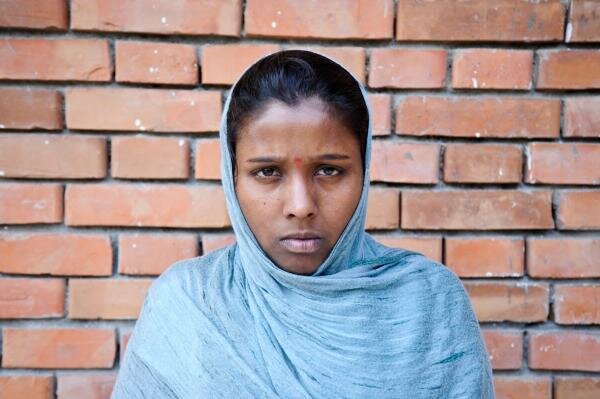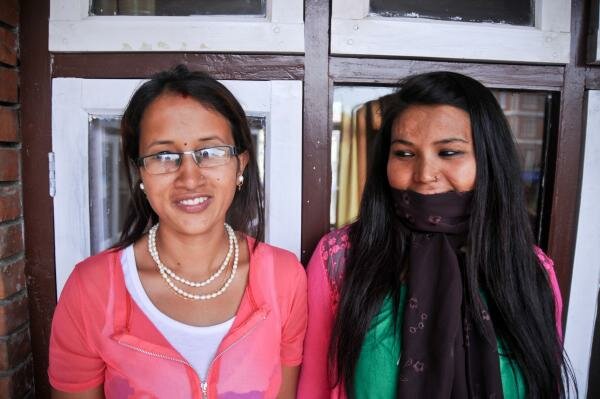Reborn from the Fire
Extreme circumstances compel burn victims in Nepal to put their faces forward in a bid to curb the violence.
 Laxmi “Goodiya” Chauhan was just 13 years old when her parents arranged for her to get married. She was resting by the fireplace when her sister-in-law decided to toss the glowing embers from the furnace onto Goodiya’s chest. The pain must have been indefinable.
Laxmi “Goodiya” Chauhan was just 13 years old when her parents arranged for her to get married. She was resting by the fireplace when her sister-in-law decided to toss the glowing embers from the furnace onto Goodiya’s chest. The pain must have been indefinable.
Goodiya, who does not speak any English, was sitting at the table across from me when I had her story translated slowly by an interpreter. When we got to the part where the glowing embers landed onto her chest, Goodiya heaves a sigh, adjusts her scarf, and looks to the ground.
Goodiya is from Nepal’s Terai district. Shy, young, and uneducated, her role in the home was to cook, clean, work the land, raise the animals, and bear children for her husband. She did all of this to the best of her abilities, except one – she could not bear any children. This was her crime.
I didn’t get to see any of Goodiya’s scars; she was too shy and ashamed to show them to me. With aid and encouragement from the staff and volunteers at Saathi and Burns Violence Survivors (BVS) Nepal, perhaps one day Goodiya will be able to stand tall and tell her story, without fear or shame, to many women in her country who need to hear it so desperately.
Many young women like Goodiya feel responsible for their plight, refusing to believe that they were in fact abused and that their perpetrators need to be penalised. Some women like 29 year-old Santi Silwal, refrains from testifying against her husband who lit the fire to her kerosene soaked body. She does not want to shame her husband or his family.
 Santi was from Nepal’s rural Dhading district, but worked for two years as a housemaid in Dubai, where she learned to speak English from a Filipino colleague. When she returned in 2007, she decided to stay in Kathmandu with her husband, who in January 2012 burned her because of a “disagreement”.
Santi was from Nepal’s rural Dhading district, but worked for two years as a housemaid in Dubai, where she learned to speak English from a Filipino colleague. When she returned in 2007, she decided to stay in Kathmandu with her husband, who in January 2012 burned her because of a “disagreement”.
“Women should be independent,” says Santi, “they need to be empowered and confident and believe they can live life on their own without their husbands.” Santi is not suggesting that women should stay single, but she wants to let women who are in abusive relationships know that they can break free from their abusers. Oftentimes, women in these situations remain with their abusers, convinced that that is what they need and that they are unable to exist independently.
More difficult to grasp were stories like those of 22 year-old Rasta K.C. who grew up in Kathmandu’s Lalitpur district. She eloped with her husband who is of a “higher caste” than she is. His parents had no plans to accept her, and they often made it known. Rasta was blamed for any misfortune that beset the family. The pressure and despair had so mounted, that a “small dispute” between her and her husband became the catalyst for her self-immolation.
“Extreme anger and frustration drove Rasta to burn herself,” explains Anjalee Maharjan, a counsellor who’s worked with the Saathi Women’s Shelter in Nepal for three years. Rasta’a intention, though unwitting, was “a desperate attempt to seek her husband’s reaction and attention.”
Maharjan explains that self-immolation is unfortunately common in Nepal, and adds that families have a huge role to play in the prevention of such self-abuse. “In many cases, family intervention prevented women under emotional stress from setting themselves on fire.” Maharjan encourages that “emotional support, and empathetic listening can spell the difference between a woman breaking down and crying, or caving in and burning herself.”
Apart from a lack of emotional support, joblessness, lack of education, and caste discrimination, have been common denominators for self-immolation cases outside of Kathmandu.
Of the four women I met, only Rasta asked to be have her photograph taken away from view of people on the street. How others value her seems to be of great importance. Unlike the other women, she is from Kathmandu city. Which might explain her emphasis on public image. But what Rasta had in common with the other burn survivors was that she had little if any self-worth, and did not feel capable of being independent.
This lack of self-worth is often impressed by the actions of family members. Uneducated elders are often superstitious and are quick to blame daughter-in-laws for any mishaps that occur in the home or even the extended family. Explains Maharjan, “unemployment combined with a lack of education means that victims and their accusers or abusers have increased contact with each other in the home. Time that should be spent productively is instead spent on conjuring suspicions.”
 Rasta and Santi are now receiving aid, shelter, education and vocational training at the Saathi Women’s Shelter, skills that will enable them to break free from physical and emotional poverty. Both women are still uncertain about their integration with society. Rasta says she sometimes gets frustrated when people look at her “judgingly” on the street, though she understands that sometimes they may just be curious about the scars on her face. “I was stupid, if I knew it was going to be this painful and that I would have to bear the scars for the rest of my life, I would not have burned myself.” Rasta confesses, before she adds that, “There is always another way out.”
Rasta and Santi are now receiving aid, shelter, education and vocational training at the Saathi Women’s Shelter, skills that will enable them to break free from physical and emotional poverty. Both women are still uncertain about their integration with society. Rasta says she sometimes gets frustrated when people look at her “judgingly” on the street, though she understands that sometimes they may just be curious about the scars on her face. “I was stupid, if I knew it was going to be this painful and that I would have to bear the scars for the rest of my life, I would not have burned myself.” Rasta confesses, before she adds that, “There is always another way out.”
Most victims received at BVS Nepal are uneducated and poor, but a significant number of cases comprise upper-middle, and upper class women. Marharjan explains that wealthy women are more likely then uneducated women to bear the wrath of their abusers for long periods of time before seeking help. “Poor women have nothing to lose, so they feel less shame and guilt from seeking help from a shelter,” shares Maharjan, adding that, “some [wealthy] women she’s currently counselling have been tolerating abuse for three to four decades, only turning to a shelter for help when they are burned, by then, it’s too late.”
Toward the end of the interview, Santi approaches to say, “I want to thank you for telling our stories. Hopefully many women will read about how we have suffered and learn that no matter how hurt they are, they should never burn themselves.”
These women were once victims, and today they are ambassadors. Despite the pain and abuse, they have risen stronger and louder, perhaps because they realise they can no longer hide their pain, even if they wanted.



 Debby Ng forayed into journalism following failed attempts at becoming a world-class equestrian. A wildlife crime investigator, underwater photographer, dive master and founder of a marine conservation organisation, she spends what remains of her time writing about the environment, its wildlife, and its people.
Debby Ng forayed into journalism following failed attempts at becoming a world-class equestrian. A wildlife crime investigator, underwater photographer, dive master and founder of a marine conservation organisation, she spends what remains of her time writing about the environment, its wildlife, and its people.













